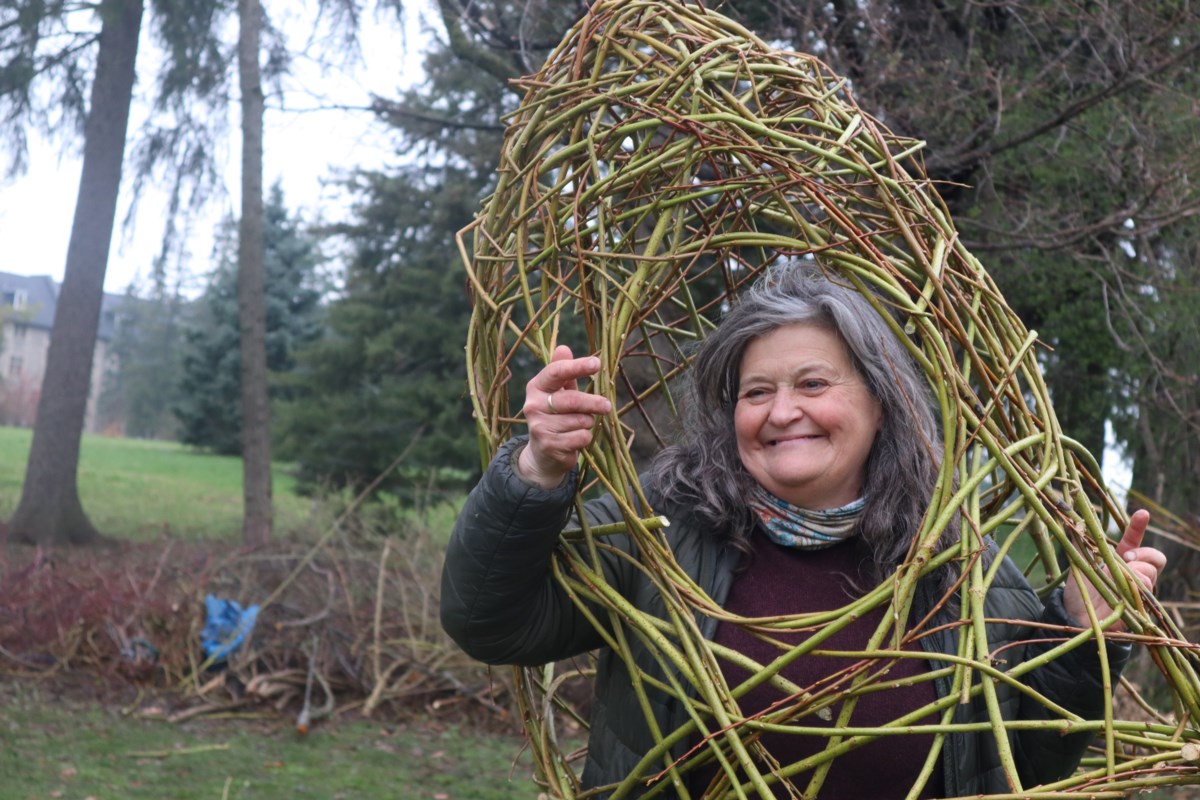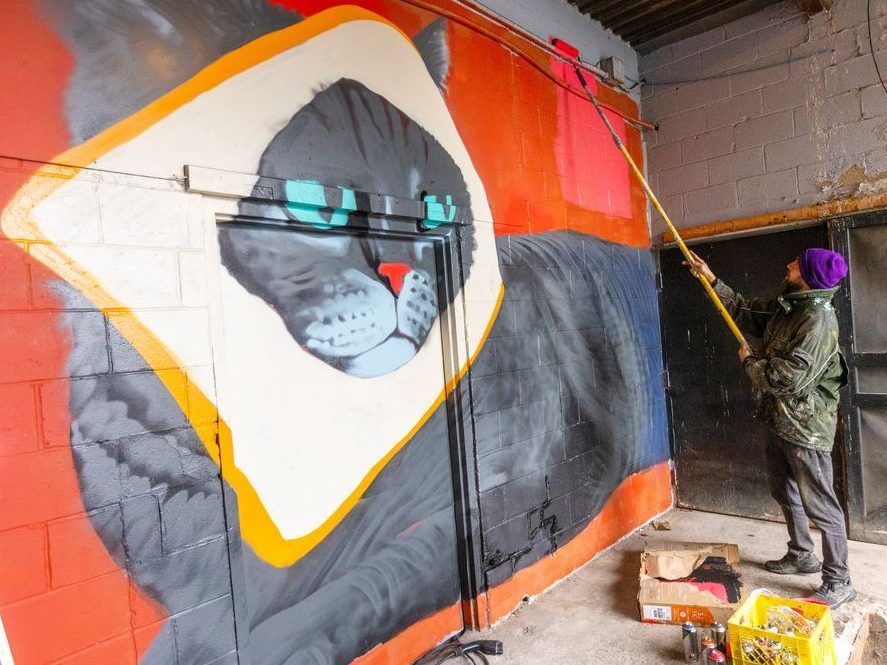Art
Calgary turns Peace Bridge into an art walk after iconic structure suffers more than $1-million in damage – The Globe and Mail
:format(jpeg)/cloudfront-us-east-1.images.arcpublishing.com/tgam/XU2NQEYFMNBT5DV35WXTYUBN4Q.JPG)
:format(jpeg)/cloudfront-us-east-1.images.arcpublishing.com/tgam/XU2NQEYFMNBT5DV35WXTYUBN4Q.JPG)
Fake paintings with glass that looks smashed hang at the Peace Bridge in Calgary. The city has turned vandalism into an art walk called Vandalism Gallery.Todd Korol/The Globe and Mail
Designed by Santiago Calatrava, one of the world’s great architects, Calgary’s Peace Bridge is a major tourist attraction and popular landmark. More than a million pedestrians and cyclists have crossed the Bow River using the glass-encased bridge in the past year.
This summer, the bridge suffered almost $1-million in damage after vandals smashed 70 of the structure’s 100 glass panels with a hammer and bricks in two separate incidents. One person has been charged.
In an effort to combat such behaviour, the City of Calgary has turned the Peace Bridge into an art walk called the Vandalism Gallery. It’s a campaign to teach people about the damage that was done to the bridge and to encourage residents to report acts of vandalism, said Charmaine Buhler, the city’s bridge maintenance manager.
Guards and security cameras now watch over the structure. Steel fence barriers have been set up while the city reviews potential repair options. Ms. Buhler said the city is also exploring the use of different types of material that are less susceptible to vandalism.
For now, the bridge and the Vandalism Gallery remain open to the public.
:format(jpeg)/cloudfront-us-east-1.images.arcpublishing.com/tgam/Y4RKZRUNQRBA5H4QDQ46GZNLFM.JPG)
:format(jpeg)/cloudfront-us-east-1.images.arcpublishing.com/tgam/Y4RKZRUNQRBA5H4QDQ46GZNLFM.JPG)
The Peace Bridge was designed by Santiago Calatrava.Todd Korol/The Globe and Mail
:format(jpeg)/cloudfront-us-east-1.images.arcpublishing.com/tgam/PW74ONHFCVABBOMHHY54DR4ZQQ.JPG)
:format(jpeg)/cloudfront-us-east-1.images.arcpublishing.com/tgam/PW74ONHFCVABBOMHHY54DR4ZQQ.JPG)
Vandalism Gallery is meant to teach the public about the damage done to the bridge.Todd Korol/The Globe and Mail
:format(jpeg)/cloudfront-us-east-1.images.arcpublishing.com/tgam/O2JZRASQ4ZESZHKQA6ZNJT6O6Y.JPG)
:format(jpeg)/cloudfront-us-east-1.images.arcpublishing.com/tgam/O2JZRASQ4ZESZHKQA6ZNJT6O6Y.JPG)
Signage in the ‘gallery.’Todd Korol/The Globe and Mail
:format(jpeg)/cloudfront-us-east-1.images.arcpublishing.com/tgam/ZCMUYJEDO5DODGBDQUUFWMT7QU.JPG)
:format(jpeg)/cloudfront-us-east-1.images.arcpublishing.com/tgam/ZCMUYJEDO5DODGBDQUUFWMT7QU.JPG)
A fence barrier set up after the bridge was vandalized.Todd Korol/The Globe and Mail
:format(jpeg)/cloudfront-us-east-1.images.arcpublishing.com/tgam/MWFQAR27SBHFJGA72VB7SSRKXM.JPG)
:format(jpeg)/cloudfront-us-east-1.images.arcpublishing.com/tgam/MWFQAR27SBHFJGA72VB7SSRKXM.JPG)
For now, the bridge and the Vandalism Gallery remain open to the public.Todd Korol/The Globe and Mail
Art
Collaborative art project highlights the artistic and healing properties of trees – GuelphToday


Combining nature, art and science came to fruition with a collaborative stick weaving project today.
At the How To Draw A Tree Wellness Circle on Johnston Green at the University of Guelph, people were welcomed to join artists Dawn Matheson and Agnes Niewiadomski to create a sculpture made out of sticks.
Trees saved Matheson’s life. She has her own challenges with mental health but being with trees in nature relaxes her and calms her mind.
“It’s just a practice I’ve developed. It grounds me,” she said.
She wanted to bring a bit about what fuels her creativity and helps her mental health to the public with this art project.
The process of the sculpture will continue to unravel in the next couple of weeks as people add sticks to it. About 50 people came out to the event on Wednesday.
Eventually the sculpture will be used as a set piece for a play put on by Guelph Collegiate Vocational Institute (GCVI) students.
“Our idea is always like, challenge yourself to try something that you’re not used to,” said Gerard Gouchro, teacher and minor head of arts at GCVI. Students came to help create pieces of art as part of the sculpture.
The project stemmed from an idea to get people engaged with the wellness circle. An art project called How To Draw A Tree was created by Matheson four years ago. Although the project is finished she hopes people will still engage with it.
The team behind the project is a mix of artists, sound composers, students, poets, ecopsychologists and more. They created sound walks. People can go through a guided tour in the Arboretum while listening to artists talk about their relationship to trees.
There are four guided sound walks onsite and each person has a tree planted at the wellness circle that they connected with while working on the project.
The stick sculpture will be a work in progress. There will be a sign that reads anyone is welcome to add a stick to the sculpture. “It’ll become a true process based community sculpture, maybe it’ll get destroyed, which is fine by me. I’m a process based artist, there’s no final product,” said Matheson.
Most of the materials used for stick weaving are sticks from trees in the Arboretum that were pruned in the winter. Instead of the material being put into a chipper “this was a great opportunity to share it here for this project,” said Justine Richardson, director of the Arboretum.
Matheson hoped with minimal instruction people felt free to add sticks to the sculpture wherever they saw fit.
“It’s just kind of come alive to see everyone’s contributions. I’m really impressed,” said Niewiadomski.
Trees are the ultimate improvisers; they move wherever the sun is, said Matheson. Trees are good listeners and you can’t experience a lot of rejection from them.
“There’s two parallel crises that are the biggest crisis in the world right now. And that’s mental illness and climate crisis,” she said. This is what the project is about.
There will be researchers from the U of G who will be studying the art project and will give feedback to see how beneficial creating a connection between people and the earth is.
The question that runs through Matheson’s mind is; how do we glean life and creativity from trees but also give back to nature?
The art piece will be up for the next couple of weeks on Johnston Green and people can contribute by adding in their own sticks.
Art
PHOTOS: 'Urban art advocates' brighten up London with public murals – The London Free Press


THIS CONTENT IS RESERVED FOR SUBSCRIBERS ONLY
Subscribe now to read the latest news in your city and across Canada.
- Exclusive articles from Ryan Pyette, Dale Carruthers, Jane Sims, Norman De Bono and others. Plus, the Noon News Roundup newsletter on weekdays and the LFP Weekender newsletter on weekends.
- Unlimited online access to London Free Press and 15 news sites with one account.
- London Free Press ePaper, an electronic replica of the print edition to view on any device, share and comment on.
- Daily puzzles, including the New York Times Crossword.
- Support local journalism.
SUBSCRIBE TO UNLOCK MORE ARTICLES
Subscribe now to read the latest news in your city and across Canada.
- Exclusive articles from Ryan Pyette, Dale Carruthers, Jane Sims, Norman De Bono and others. Plus, the Noon News Roundup newsletter on weekdays and the LFP Weekender newsletter on weekends.
- Unlimited online access to London Free Press and 15 news sites with one account.
- London Free Press ePaper, an electronic replica of the print edition to view on any device, share and comment on.
- Daily puzzles, including the New York Times Crossword.
- Support local journalism.
REGISTER / SIGN IN TO UNLOCK MORE ARTICLES
Create an account or sign in to continue with your reading experience.
- Access articles from across Canada with one account.
- Share your thoughts and join the conversation in the comments.
- Enjoy additional articles per month.
- Get email updates from your favourite authors.
Art
Squatters at Gordon Ramsay's Pub Have 'Left the Building' After Turning It Into an Art Café – PEOPLE
:max_bytes(150000):strip_icc():focal(749x0:751x2)/gordon-ramsey-tout-3-091423-e37ac7b907264ee4b9f80a5767133502.jpg)
:max_bytes(150000):strip_icc():focal(749x0:751x2)/gordon-ramsey-tout-3-091423-e37ac7b907264ee4b9f80a5767133502.jpg)
Squatters occupying one of Gordon Ramsay’s London pubs have vacated the property, one week after police were made aware of their activity.
The Camden Art Cafe, an “autonomous cafe” who had identified themselves as the occupants of the celebrity chef’s York & Albany pub, shared the news in an Instagram post.
“We are sad to announce Camden art collective have left the building after being served papers yesterday,” the post read. “We wish those left in the building the best of luck in their endeavours. We hope to be a part of the community again soon, watch this space!!”
The account did not specify who is left in the building, and London’s Metropolitan Police could not immediately be reached by PEOPLE for comment.
On April 13, BBC reported that the Central London pub had been occupied by at least six people, who allegedly boarded the windows. PEOPLE confirmed on April 15 that Ramsay’s pub had been occupied by squatters.
Ray Tang/Shutterstock
The building where York & Albany was located and rented by Ramsay was listed on the market for £13 million, or about $16 million U.S. dollars, in December.
The Camden Art Cafe spoke about the price when they shared an official statement on April 15 about occupying the building.
“We aim to open our doors regularly to anyone and everyone, particularly the people of Camden who have been victims of gentrification and parasitic projects like HS2,” the statement said, adding that they will provide free food and “space to display their art without the ridiculous red-tape that galleries require people to jump over.”
The post continued, talking about how the wealth disparities in Camden made it “fitting that £13 million properties that most locals would never be able to afford to visit should be opened up to all.”
On April 15, the Metropolitan Police told PEOPLE that they were made aware of the squatters at a “disused property” near London’s Regent’s Park on April 10.
“This is a civil matter and so police did not attend as an emergency call out,” the statement continued.
In the statement, the police said they would get involved if necessary: “We [are] in the process of identifying if any subsequent offences [sic] have occurred, and will take action where appropriate.”
Ramsay’s team declined to comment on the situation since it is being handled legally.
According to the U.K.’s official squatter rules on the government website, “Simply being on another person’s non-residential property without their permission is not usually a crime.”
But the website lists vandalization, not leaving when ordered by the court and using utilities as crimes that would permit police involvement.
-



 Sports22 hours ago
Sports22 hours agoTeam Canada’s Olympics looks designed by Lululemon
-
News23 hours ago
Richard Chevolleau Short Film “Marvelous Marvin” Set to go to Camera
-
Business21 hours ago
Firefighters battle wildfire near Edson, Alta., after natural gas line rupture – CBC.ca
-



 Tech14 hours ago
Tech14 hours agoiPhone 15 Pro Desperado Mafia model launched at over ₹6.5 lakh- All details about this luxury iPhone from Caviar – HT Tech
-



 Sports14 hours ago
Sports14 hours agoLululemon unveils Canada's official Olympic kit for the Paris games – National Post
-



 Investment22 hours ago
Investment22 hours agoWall Street bosses cheer investment banking gains but stay cautious
-



 Sports23 hours ago
Sports23 hours agoCelebrini tops Central Scouting North American ranking for 2024 NHL Draft
-



 Politics20 hours ago
Politics20 hours agoTrump gave MAGA politicians permission to move left on abortion. Some are taking it. – Semafor





